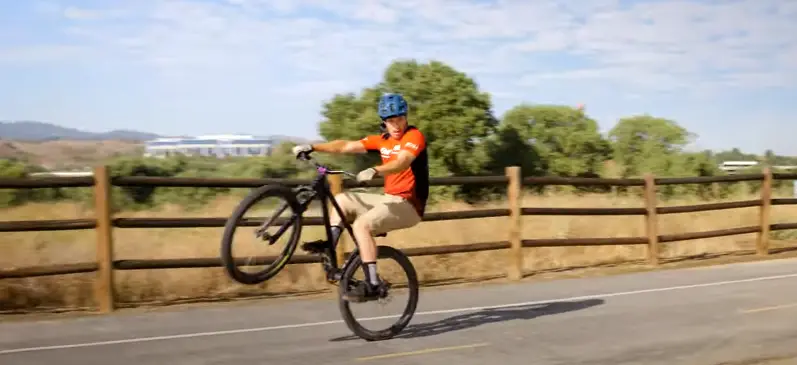Wheelieing a mountain bike can be an enjoyable and difficult experience, especially for beginners who are looking to add some style to their riding skills. Not only does it give you a sense of accomplishment, but it also enhances your overall control and balance on the bike.
Whether you need to impress your mates or simply improve your bike handling, wheelieing is a fun and practical skill to learn. Here in this guide, we’ll go through the steps, tips, and common mistakes to allow you to successfully learn how to wheelie a mountain bike for beginners.
What is a Wheelie?
A wheelie is a bicycle trick in which the rider balances on the back wheel while raising the front wheel off the ground. A wheelie is one of the most popular tricks in cycling that adds style and demonstrates control. Wheelies are widely regarded as a sign of biking confidence and ability.
Since the front wheel is still in the air, the rider will have to focus on the balance, using body position and pedal pressure to maintain control over the rear wheel. The goal is to keep the front wheel in the air for as long as possible while staying steady on the bike.
Why Should Beginners Learn to Wheelie?
The wheelie not only enhances your bike control but also boosts confidence and control of your mountain bike. As a beginner, learning to wheelie is a great way to get to know your bike, building balance and stability. The trick reminds the rider of the importance of weight distribution and core muscles.
Additionally, knowing how to wheelie can give you the confidence to ride over objects more effectively, which will improve your overall biking performance. It’s a challenging but rewarding endeavor that gives you a feeling of accomplishment and allows you to explore new ways of riding and performing on your mountain bike.
Step-by-Step Guide to Doing a Wheelie
Step 1: Prepare Your Bike
Before attempting a wheelie, ensure your mountain bike is in good condition and properly set up for balance and comfort. Check the tire pressure, brake functionality, and make sure your saddle is adjusted to a height that allows for full leg extension. Your bike should be lightweight and responsive, which helps in maintaining control while performing tricks.
Ensure that the suspension is set correctly and the handlebars are comfortable to hold, which will absorb any shock if the front wheel is raised.
Step 2: Find a Safe, Open Space
Find a flat open area free of obstructions, such as a parking lot or a wide dirt track. It’s best to practice in a controlled area where you will not have to deal with unexpected bumps or any other obstacles that could make you lose your balance.
A soft, even surface such as grass or dirt is better to prevent your bike from getting damaged. Ensure that the space is free from other individuals, cars, or objects that could lead to an accident while learning.
Step 3: The Ideal Position on the Bike Sit
On the seat with feet on the pedals, knees slightly bent, and arms slightly bent as well to maintain control. Your body should be upright but not rigid. You should be prepared to shift your weight forward or backward easily to balance.
Elbows are slightly bent so that you may pull up on the handlebars while keeping your body over the motorcycle. Good body positioning is what balances the wheelie.
Step 4: Pedal and Pull Up on the Handlebars
To raise the front wheel, begin pedaling at a moderate pace and then apply pressure to the pedals while pulling up on the handlebars.
The trick is to use the momentum from your pedaling to help you lift the front wheel while you pull up on the handlebars simultaneously.
Focus on using a quick, controlled motion rather than pulling the handlebars too hard. This will control the speed of the wheelie, so ensure that you have enough pedal pressure to keep the front wheel in the air.
Step 5: Balance and Control
To balance the front wheel in the air, you need to use your body weight and your rear brake to prevent you from flipping over backward. Your body needs to lean backward slightly as the front wheel rises to keep the bike in balance.
- You can also use the rear brake to gradually lower the front wheel if you lean too far back.
- It is a delicate balance between pulling hard enough to lift the wheel and not pulling so hard that you lose your balance.
Common Mistakes Beginners Do While Wheelieing
It’s not hard to commit some mistakes while learning skills to wheelie; the most frequent ones are listed below, which to avoid.
Error 1: Insufficient Pedaling
Not using enough force on the pedals will result in the front wheel not taking off the ground. Novices usually try to pull the handlebars and are not using enough force on the pedals. Pulling and pedaling together is required for the creation of the lift needed for a wheelie.
Error 2: Too much pulling of the Handlebars
Pull the handlebars too hard, and the bike will turn over on its back, making the trick harder to control. It is natural to pull the handlebars strongly up, but a soft, controlled pull will perform much better. Pulle the handlebars too hard, and you’ll find yourself in a dangerous spill because you are out of control of the bike.
Error 3: Losing Balance
Lack of proper body control and improper rear brake application can lead to losing balance and falling off the bike. To keep the front wheel in the air, you must transfer your weight appropriately. Improper brake application can either get you to fall back or let the front wheel drop too quickly.
Tips for Improving Your Wheelie
Once you feel at ease with it, the following are some tips to enhance your wheelie and reach the next level.
Tip 1: Practice at Low Speed
Start slowly and get a sense of balance and feel of the bike. If it’s too fast, it will be more difficult to control your wheelie if you’re just a beginner. Slow and steady is the way to go so that you can focus on technique rather than speed.
Tip 2: Smooth Pedal Strokes
Ensure your pedaling motion is smooth and consistent to maintain the lift in a steady manner. Sudden pedaling has a tendency to spoil the rhythm of the wheelie and make it harder to balance. Try to establish a pace that makes the control of the lift easier.
Tip 3: Use Your Rear Brake for Balance
Use the rear brake to gradually control the elevation of the wheelie and not tip over the back. When you lift the front wheel, you will need to use the rear brake to shift your balance. This will keep you in command but prevent turning over backwards.
How to Make Your Wheelies Last Longer
Now that you have learned how to do the first wheelie, you may wonder how to make your wheelie last longer. To maintain your wheelie for a longer time, you have to focus on your balance and body position. Leaning back slightly will keep the front wheel up in the air, and even pedaling will provide you with the speed for a longer wheelie.
A slight touch of the rear brake can also be helpful in keeping you in control without overcompensating. Practice in a safe environment and build up the distance progressively as your confidence and skill level grow.
FAQ’s
What is the easiest way to learn to wheelie a mountain bike?
The easiest way to learn is by practicing in a flat, open area and starting with brief wheelies at low speeds and focusing on balance and control.
How long does it take to learn to wheel a mountain bike?
The learning time varies, but most novices are able to get a basic wheelie in a few weeks with regular practice.
Do I have to use a particular model of mountain bike to wheelie?
A standard mountain bike will do, but a hard-working, responsive frame and good brakes make it easier to control.
Can I practice wheelies on hills or slopes?
Practice on level ground first until you are happy, because hills will make balance more difficult and the wheelie trick harder to master.
What if my wheelie still flips over?
If your wheelie is overturning, focus on speed control and squeeze on the rear brake to gradually bring the front wheel back down.
Can I master the wheelie without ever falling?
Although there are going to be some spills when you are first learning, practicing in a safe area, using protection gear, and taking it slow will minimize the chances of getting hurt.
How can I make my wheelie last longer?
Beginning sentence: “To make your wheelie last longer, try pedaling consistently, use your body to balance out, and slowly apply the rear brake to adjust your height.”
Will wheelies damage my mountain bike?
Beginning sentence: “If properly done, wheelies won’t hurt your bike. But too much pressure on the brakes and front fork will wear them out over time, so practice safely.”
Conclusion
With practice, patience, and time, you will be wheelie-ing in no time, showing off to the rest of your riders. While it’ll take you a while to get the trick, it is well worth it, giving you confidence and bike-control too. Stay at it and do not be discouraged by falls along the way – they’re part of the learning process!

I am Ryan Ford, a mountain biking enthusiast who loves to explore the outdoors. I also like to go on adventures with friends and anything else that involves being outside. I love my bike because it gets me out of the house and gives me an opportunity to enjoy nature.

